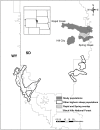Disease and predation: sorting out causes of a bighorn sheep (Ovis canadensis) decline
- PMID: 24516623
- PMCID: PMC3917862
- DOI: 10.1371/journal.pone.0088271
Disease and predation: sorting out causes of a bighorn sheep (Ovis canadensis) decline
Abstract
Estimating survival and documenting causes and timing of mortality events in neonate bighorn sheep (Ovis canadensis) improves understanding of population ecology and factors influencing recruitment. During 2010-2012, we captured and radiocollared 74 neonates in the Black Hills, South Dakota, of which 95% (70) died before 52 weeks of age. Pneumonia (36%) was the leading cause of mortality followed by predation (30%). We used known fate analysis in Program MARK to estimate weekly survival rates and investigate the influence of intrinsic variables on 52-week survival. Model {S1 wk, 2-8 wks, >8 wks} had the lowest AIC c (Akaike's Information Criterion corrected for small sample size) value, indicating that age (3-stage age-interval: 1 week, 2-8 weeks, and >8 weeks) best explained survival. Weekly survival estimates for 1 week, 2-8 weeks, and >8 weeks were 0.81 (95% CI = 0.70-0.88), 0.86 (95% CI = 0.81-0.90), and 0.94 (95% CI = 0.91-0.96), respectively. Overall probability of surviving 52 weeks was 0.02 (95% CI = 0.01-0.07). Of 70 documented mortalities, 21% occurred during the first week, 55% during weeks 2-8, and 23% occurred >8 weeks of age. We found pneumonia and predation were temporally heterogeneous with lambs most susceptible to predation during the first 2-3 weeks of life, while the greatest risk from pneumonia occurred from weeks 4-8. Our results indicated pneumonia was the major factor limiting recruitment followed by predation. Mortality from predation may have been partly compensatory to pneumonia and its effects were less pronounced as alternative prey became available. Given the high rates of pneumonia-caused mortality we observed, and the apparent lack of pneumonia-causing pathogens in bighorn populations in the western Black Hills, management activities should be geared towards eliminating contact between diseased and healthy populations.
Conflict of interest statement
Figures


Similar articles
-
Spatio-temporal dynamics of pneumonia in bighorn sheep.J Anim Ecol. 2013 May;82(3):518-28. doi: 10.1111/1365-2656.12031. Epub 2013 Feb 8. J Anim Ecol. 2013. PMID: 23398603
-
Survival of bighorn sheep (Ovis canadensis) commingled with domestic sheep (Ovis aries) in the absence of Mycoplasma ovipneumoniae.J Wildl Dis. 2012 Jan;48(1):168-72. doi: 10.7589/0090-3558-48.1.168. J Wildl Dis. 2012. PMID: 22247385
-
Mortality during epizootics in bighorn sheep: effects of initial population size and cause.J Wildl Dis. 2010 Jul;46(3):763-71. doi: 10.7589/0090-3558-46.3.763. J Wildl Dis. 2010. PMID: 20688682
-
Assessing Timing and Causes of Neonatal Lamb Losses in a Bighorn Sheep ( Ovis canadensis canadensis ) Herd via Use of Vaginal Implant Transmitters.J Wildl Dis. 2017 Jul;53(3):596-601. doi: 10.7589/2016-10-239. Epub 2017 Feb 13. J Wildl Dis. 2017. PMID: 28192042
-
Bighorn sheep pneumonia: sorting out the cause of a polymicrobial disease.Prev Vet Med. 2013 Feb 1;108(2-3):85-93. doi: 10.1016/j.prevetmed.2012.11.018. Epub 2012 Dec 17. Prev Vet Med. 2013. PMID: 23253148 Review.
Cited by
-
Removal of chronic Mycoplasma ovipneumoniae carrier ewes eliminates pneumonia in a bighorn sheep population.Ecol Evol. 2020 Mar 5;10(7):3491-3502. doi: 10.1002/ece3.6146. eCollection 2020 Apr. Ecol Evol. 2020. PMID: 32274004 Free PMC article.
-
Changes in movement, habitat use, and response to human disturbance accompany parturition events in bighorn sheep (Ovis canadensis).Mov Ecol. 2023 Jul 4;11(1):36. doi: 10.1186/s40462-023-00404-2. Mov Ecol. 2023. PMID: 37403172 Free PMC article.
-
Impact of Mycoplasma ovipneumoniae on juvenile bighorn sheep (Ovis canadensis) survival in the northern Basin and Range ecosystem.PeerJ. 2021 Jan 19;9:e10710. doi: 10.7717/peerj.10710. eCollection 2021. PeerJ. 2021. PMID: 33552728 Free PMC article.
-
Disease Ecology of a Low-Virulence Mycoplasma ovipneumoniae Strain in a Free-Ranging Desert Bighorn Sheep Population.Animals (Basel). 2022 Apr 14;12(8):1029. doi: 10.3390/ani12081029. Animals (Basel). 2022. PMID: 35454275 Free PMC article.
-
Developmental dynamics of cloned Mexican bighorn sheep embryos using morphological quality standards.Vet Med Sci. 2020 Aug;6(3):382-392. doi: 10.1002/vms3.242. Epub 2020 Jan 29. Vet Med Sci. 2020. PMID: 31995671 Free PMC article.
References
-
- Buechner HK (1960) The bighorn sheep in the United States, its past, present, and future. Wildl Monogr 4: 1–174.
-
- Singer FJ, Zeigenfuss LC, Spicer L (2001) Role of patch size, disease, and movement in rapid extinction of bighorn sheep. Conserv Biol 15: 1347–1354.
-
- Wehausen JD, Kelley ST, Ramey RR (2011) Domestic sheep, bighorn sheep, and respiratory disease: a review of the experimental evidence. California Fish and Game 97: 7–24.
-
- Fitzsimmons NN, Buskirk SW, Smith MH (1995) Population history, genetic variability, and horn growth in bighorn sheep. Conserv Biol 9: 314–323.
-
- Gaillard JM, Festa-Bianchet M, Yoccoz NG, Loison A, Toigo C (2000) Temporal variation in fitness components and population dynamics of large herbivores. Annu Rev Ecol Syst 31: 367–393.
Publication types
MeSH terms
LinkOut - more resources
Full Text Sources
Other Literature Sources

